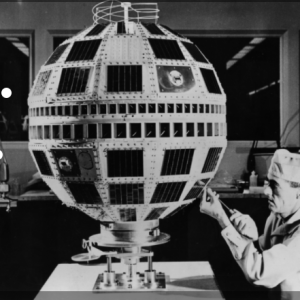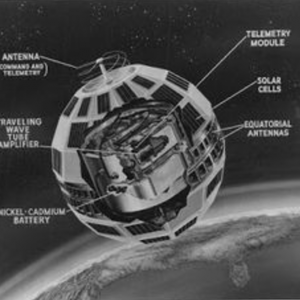aNewDomain — There aren’t many technologies that change the world. Not fundamentally.
— There aren’t many technologies that change the world. Not fundamentally.
Radio, TV, the telephone and, certainly, computer technology are obviously on the short list.
But there’s one tech innovation that dwarfs them all. And that’s the three-foot long, beach ball-shaped shock of metal, wires and antennae called Telstar-1.
Developed by Bell Telephone Laboratories for AT&T and launched on July 10, 1962, Telstar was the planet’s first ever commercial payload in space — and the first ever active communications satellite.
It enabled the first, live transatlanticTV broadcast 13 days later — and the first live sportscast and the first live press conference, hosted by Pres. John F. Kennedy. (Watch all three below the fold)
 It was the first time video, radio signals, fax images and telephone calls were sent into space. Today, 55 years later, we’re paying tribute to Telstar, which in many ways launched the modern world we live in now.
It was the first time video, radio signals, fax images and telephone calls were sent into space. Today, 55 years later, we’re paying tribute to Telstar, which in many ways launched the modern world we live in now.
Here’s how it did it.
Live, via satellite
It’s rare, of course, that people are aware of such giant technological and cultural shifts as they happen. But they did with Telstar.
Two days after its launch, on July 12, 1962, Telstar broadcast its first transatlantic image — of a flag flying over Andover, MA. That was the appetizer.
The big payoff happened 13 days later with its transmission of the first transatlantic broadcast, a historic live satellite program featuring the world’s top news anchors, plus live sports and Kennedy’s press conference, which managed to move financial markets.
Another first.
Famed journalist Walter Cronkite’s face was the first face anyone saw on this first-ever, live satellite feed. Joined by his TV news rival, Chet Huntley, along with the BBC’s Richard Dimbleby, Cronkite showed a side-by-side live shot of the Statue of Liberty and the Eiffel Tower.
 “The plain facts of electronic life are that Washington and the Kremlin are now no farther apart than the speed of light, at least technically,” he said.
“The plain facts of electronic life are that Washington and the Kremlin are now no farther apart than the speed of light, at least technically,” he said.
And Cronkite and his cohosts were just getting started. The broadcast next showed part of a live pro baseball game out of Chicago’s Wrigley Field. It was the Phillies versus the Cubs. Cal Koonce pitched to Tony Taylor, who hit the ball to right fielder Goerge Altman.
From there, the video switched to Kennedy with reporters in Washington, DC.
As background, most business and finance people watching this live would’ve known that European gold markets had been wildly shifting because of rumors that the US was about to devalue the dollar. Kennedy used the historic occasion to addressed this issue head on. As the world looked on live, he took a reporter’s question about the rumor and then denied it — vehemently.
The dollar started gaining strength minutes later.
Talk about the start of something big.
Watch the historic live broadcast from July 23, 1962 below. The segment showing just Kennedy’s press conference is below that …
Here’s the Kennedy press conference from that historic, live broadcast:
Live … via satellite
When Telstar-1 launched off the back of a Thor/Delta on July 10, 1962, it wasn’t much to look at. It was just an aluminum ball with antennae and barely a meter across. It used only about 1/8 the power of your typical Macbook.
Its power was all solar generated, by the way.Telstar-1 employed some 3,600 solar panels mounted on its hull.
 As for its capacity, Telstar-1 could carry and transmit just 600 phone calls and one single black and white live TV channel. Not much, you’re thinking. But back then, well, it was more than enough.
As for its capacity, Telstar-1 could carry and transmit just 600 phone calls and one single black and white live TV channel. Not much, you’re thinking. But back then, well, it was more than enough.
No one ever said the three words, “Live, via satellite,” before Telstar-1. Then they did. And a new era dawned.
Mission accomplished
Imagine how astounding that would be, to see that first, historic live broadcast as it happened.
Before this, TV signals traveled over landlines and in the air by a system of microwave towers, point to point. That’s why the ocean was such a monolithic barrier.
Telegraph was the fastest way to get news of a big event across the world, but you couldn’t see it. You couldn’t hear it. You couldn’t watch and listen as history was being made — or have any dreams or ideas about making it yourself.
But satellite transmission as pioneered by Telstar-1 suddenly, astoundingly made it possible for faces, voices and images to instantaneously cross that uncrossable chasm.
It wasn’t long before long-distance phone calls and live, international TV news became a common thing that didn’t impress anyone much anymore.
But oh, that first time.
Now, Telstar-1 wasn’t long for this world, we should add.
Telstar hung in low, non-geosynchronous orbit until November 1962. Radiation killed its on-board electronics, NASA said. In 2012, Scientific American expounded on that obituary, saying that “AT&T has launched Telstar 1, the first commercial communications satellite, right into the middle of a radiation storm produced by a nuclear test.”
Well, anyway.Telstar-1’s mission was accomplished. But the revolution it sparked?
It’s still going on.
Happy birthday, Telstar 1.
For aNewDomain, I’m Gina Smith.
Some content for you:
Here’s a 1963 documentary about the Telstar-1 launch. It’s great.
Now check out Telstar — by the Tornados. It was what is now generally known as “space age pop,” a novelty song. It features a funky instrument called a clavioline, an early electronic keyboard like instrument that actually is a direct ancestor of the analog synthesizer.













